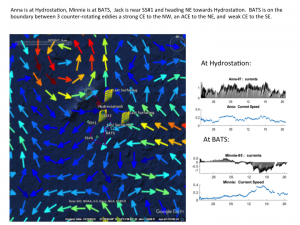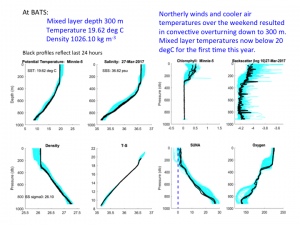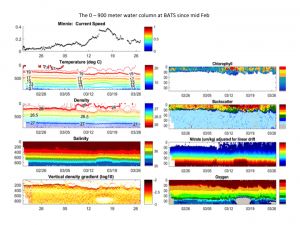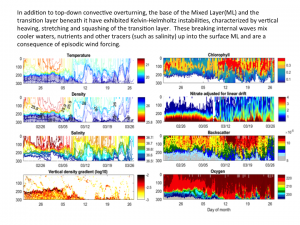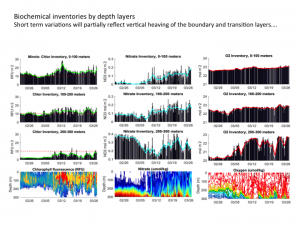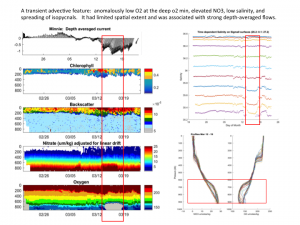Anna and Minnie were deployed from RV Atlantic Explorer on February 20, 2017 – Anna at Hydrostation S and Minnie at BATS. Anna is quipped with a standard set of sensors: CTD, optical fluorescence, backscatter and CDOM, and dissolved oxygen; Minnie is similarly equipped with the addition of a nitrate sensor. Both gliders are holding station and making about 8 dives each day. Jack was recovered February 27, had its battery replaced and redeployed on March 13, with standard sensors plus an Acoustic Doppler Current Profiler (ADCP). Since then, Jack has been observing the water column structure in transects between the BATS and Hydrostation S.
The local eddy circulation is complicated. BATS is on the boundary between 3 counter-rotating eddies: a strong Cyclonic Eddy to the NW, an Anticyclonic Eddy to the NE, and weak Cyclonic Eddy to the SE. Northerly winds and cooler air temperatures at BATS over the weekend resulted in convective overturning down to 300 m. Mixed layer temperatures at BATS are now below 20oC for the first time this year.
In addition to top-down convective overturning, the base of the Mixed Layer (ML) and the transition layer beneath it have exhibited Kelvin-Helmholtz instabilities, characterized by vertical heaving, stretching and squashing of the transition layer. Beginning in early March, these breaking internal waves have mixed cooler waters, nutrients and other tracers (such as salinity) up into the surface mixed layer and are a consequence of episodic wind forcing. This increase in the delivery of nitrate (NO3) to the photic zone increased phytoplankton productivity and has resulted in an increase in chlorophyll concentration, dissolved oxygen, and optical backscatter in the surface waters at BATS.
An additional, transient advective feature occurred in mid-March at BATS: anomalously low O2 at the deep O2 min, elevated NO3, low salinity, and spreading of isopycnals. It had limited spatial extent and was associated with strong depth-averaged flows.


